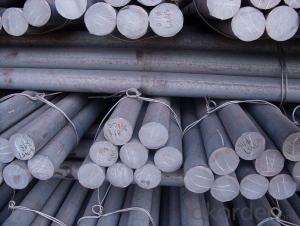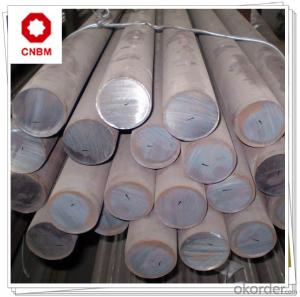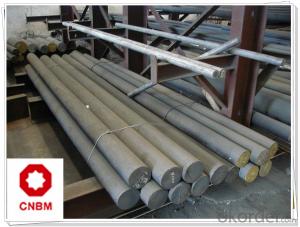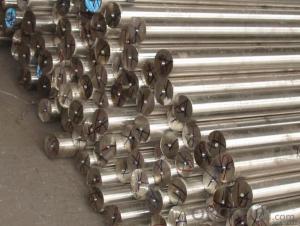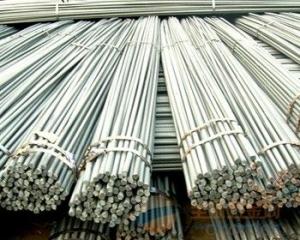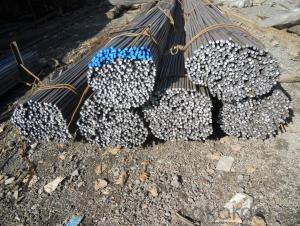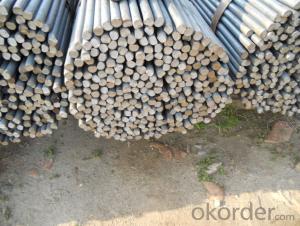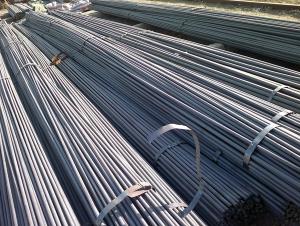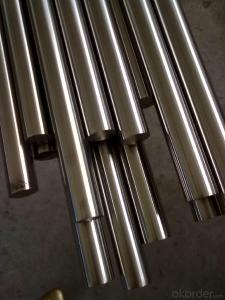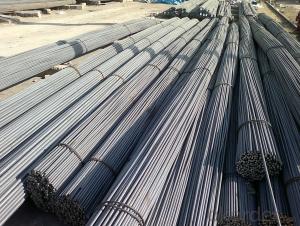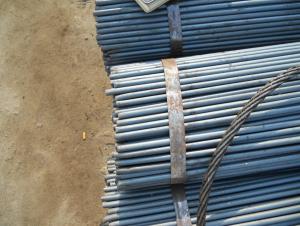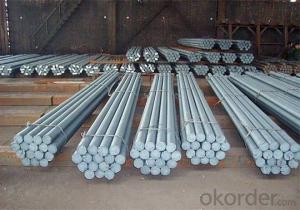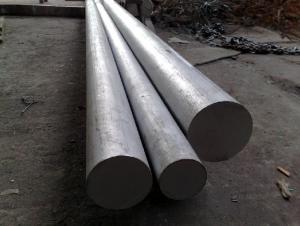Hot sell round steel bar for construction
- Loading Port:
- Tianjin
- Payment Terms:
- TT OR LC
- Min Order Qty:
- 25000 m.t.
- Supply Capability:
- 10000 m.t./month
OKorder Service Pledge
OKorder Financial Service
You Might Also Like
Specifications of Common Steel Round Bar
1. Grade: 304, 316L, 321
2. Type: Mild carbon steel
3. Shape: Round bar, solid bar of steel with circular section
4. Diameter: 8mm-150mm
5. HS Code: 72283010
Usage and Applications of Common Steel Round Bar
1. Common Steel Round Bar of 8-25mm, or small round is mostly used for straight bundles supply, and used for steel, bolts and various mechanical parts. While the bigger round bar, or more than 25mm hot rolled bar, is mainly for the manufacture of mechanical parts or for seamless steel billet.
2. Steel round bar is used in construction and a large number of architectural and engineering structures.
3. Besides, we can supply some especial material steel round bar that can be used for main shaft of steamer, hummer shank, with big section and supper force.
Packaging & Delivery of High Quality Round Bar
Packaging Detail: All goods are packed in bundle with steel strips and shipped by break bulk vessel or container (depend on target market and different ports)
Delivery Detail: 45 days
Trade terms: FOB, CFR, CIF
MOQ: 25 tons per specification; we can negotiate the quantity if the specification is normal or we have stock of one specification.
Weight: The price invoicing on theoretical weight basis or actual weight basis depends on customer’s request.
Shipment: The shipment of bulk break or container is depends on customer’s request and the situation of the port of destination.
Documents given: Full set of original clean on board bill of lading; Original signed commercial invoice; Original packing list; Policy of insurance; Certificate of origin and what the target market needs.
Production Flow of High Quality Round Bar
The common processes are preheated forging quenching, dual refinement solution process, cooling quenching and isothermal quenching. We use heat treatment for dual refinement solution process. The main measures process is high temperature solution and refinement cycle. High temperature solution can improve the carbide morphology and particle size. The aim is to make the loop refinement ultrafine austenite grains.
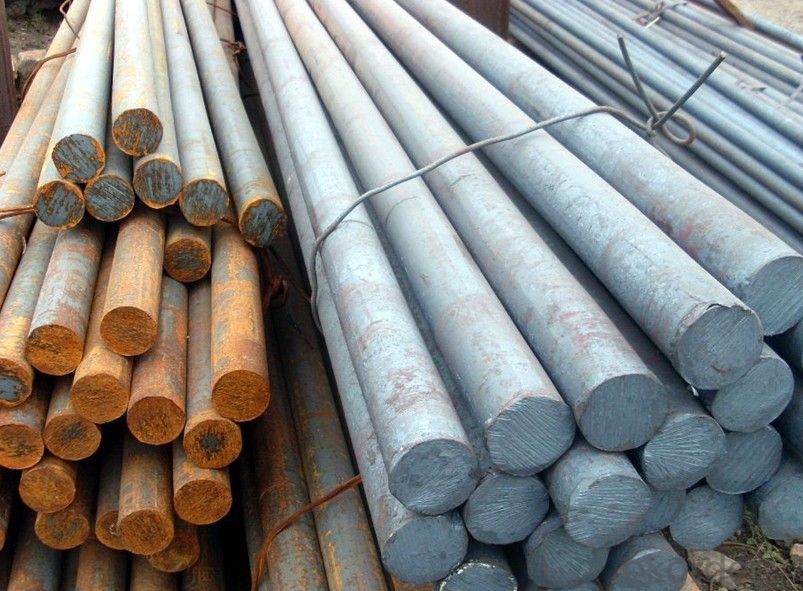
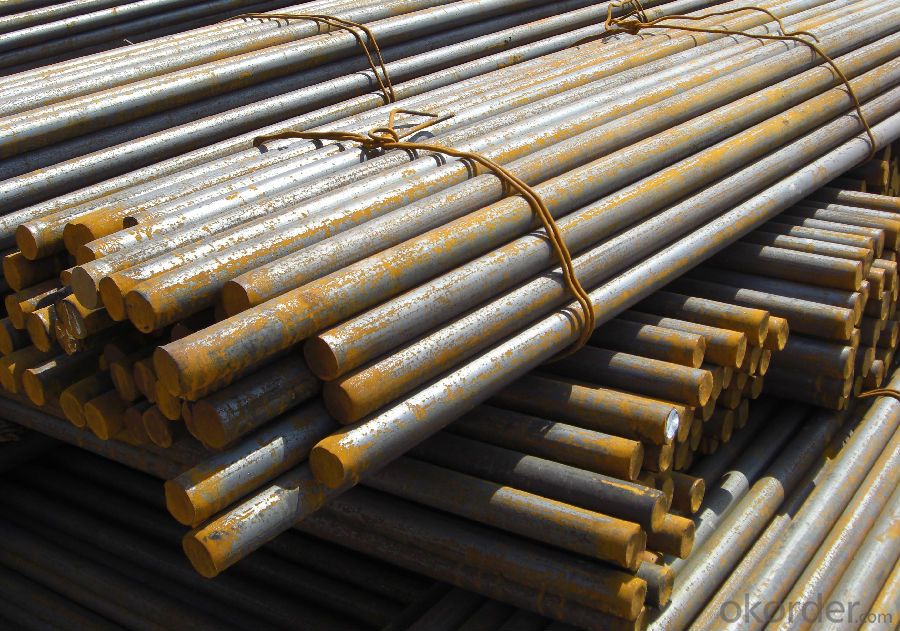

- Q: Can steel round bars be used in the agricultural industry?
- Indeed, the agricultural industry can utilize steel round bars. Within this sector, there exists a broad array of applications for them, including the construction of fences, gates, and livestock enclosures. Moreover, steel round bars are frequently employed as support and reinforcement in structures like barns, sheds, and agricultural machinery. Due to their exceptional strength and durability, they are well-suited for enduring the challenging conditions and heavy loads often encountered in agricultural environments. Furthermore, steel round bars can undergo further processing and fabrication, resulting in an assortment of agricultural tools and equipment, such as hitches, plows, and cultivators. In summary, steel round bars represent a versatile and dependable material capable of effectively satisfying the agricultural industry's requirements.
- Q: What is the density of a steel round bar?
- The density of a steel round bar can vary depending on the specific type and composition of the steel, but on average, the density of steel is about 7.85 grams per cubic centimeter (g/cm³) or 7850 kilograms per cubic meter (kg/m³). This means that for a given volume of steel round bar, the weight or mass of the bar can be calculated by multiplying its volume by its density.
- Q: How are steel round bars used in the manufacturing of lifting equipment?
- Due to their strength, durability, and versatility, steel round bars are commonly used in the manufacturing of lifting equipment. These bars are typically made from high-quality steel alloys like carbon steel or alloy steel, which provide the necessary strength and toughness for lifting heavy loads. In the manufacturing process, steel round bars serve as the main structural component of lifting equipment such as cranes, hoists, and lifting hooks. They are utilized to create the frame and support structures that ensure stability and load-bearing capacity. Moreover, steel round bars are employed to fabricate various lifting components like shafts, axles, and pins. These components play a crucial role in the proper functioning of lifting equipment and are designed to withstand high levels of stress and strain. The use of steel round bars guarantees that they can handle heavy loads without deforming or failing. Additionally, steel round bars are frequently used to manufacture lifting hooks and chains. Lifting hooks are essential for attaching the load to the lifting equipment, while chains secure and lift the load. Steel round bars provide the necessary strength and rigidity to handle the weight of the load, ensuring safe and efficient lifting operations. Furthermore, manufacturers can machine, forge, or heat-treat steel round bars to achieve specific mechanical properties required for lifting equipment manufacturing. This flexibility allows manufacturers to customize the bars to meet the specific requirements of different lifting applications, such as withstanding high temperatures or resisting corrosion. In conclusion, steel round bars are indispensable in the manufacturing of lifting equipment. Their strength, durability, and versatility make them ideal for creating the structural frames, support structures, and lifting components necessary for safe and efficient lifting operations.
- Q: How are steel round bars stored?
- Steel round bars are typically stored in a vertical position, either stacked on racks or placed in specially designed shelves or racks. These storage methods ensure that the bars are well-supported and easily accessible for transportation and use. Additionally, steel round bars are often bundled or strapped together to prevent them from rolling or becoming disorganized.
- Q: How do you straighten a bent steel round bar?
- To straighten a bent steel round bar, you can follow a few simple steps: 1. Assess the bend: Determine the severity and location of the bend in the round bar. This will help you decide which method to use for straightening. 2. Heat the bar: If the bend is not too severe, you can heat the bar using a blowtorch or a forge. Apply heat evenly across the bent area until it becomes red hot. Heating the bar will make it more malleable and easier to straighten. 3. Apply pressure: Once the bar is heated, you can use a vice or a hydraulic press to apply pressure on the bent section. Gradually increase the pressure until the bar starts to straighten. Be careful not to apply excessive force as it may cause the bar to break. 4. Use leverage: If the bend is not too severe, you can also use leverage to straighten the bar. Secure one end of the bar in a vice or clamp and apply force to the bent section in the opposite direction. Slowly and gently increase the force until the bar straightens. 5. Cold bending: If the bend is minor, you may be able to straighten the bar without applying heat. This method involves using a hammer or mallet to gently tap the bent area in the opposite direction until it straightens. Be cautious not to strike the bar too hard, as it may create new bends or fractures. 6. Check for straightness: After applying the straightening method, carefully inspect the bar to ensure it is straight. If there are any remaining bends, repeat the process until the bar is completely straight. Remember to wear appropriate safety gear, such as gloves and eye protection, when working with steel bars. It is also advisable to consult a professional if you are unsure about the straightening process or if the bar is severely bent.
- Q: How do you straighten steel round bars?
- To straighten steel round bars, you can use a variety of methods depending on the level of precision required and the size of the bars. Here are a few common techniques: 1. Manual Straightening: This method is suitable for smaller diameter round bars. Place the bar on a flat surface and apply pressure to the bent section using a hydraulic or manual press. Gradually increase the force until the bar is straightened. This technique is relatively simple but may not yield perfect results. 2. Heat Straightening: Heat straightening is effective for larger diameter round bars or bars with severe bends. Heat the bent section using an oxy-acetylene torch until it becomes red hot. Once heated, apply pressure in the opposite direction of the bend using hydraulic or manual tools. The heat softens the steel, allowing it to be manipulated easier. Be cautious not to overheat the steel, as it may weaken its structural integrity. 3. Roller Straightening: This method is commonly used in industrial settings and is suitable for larger diameter round bars. The bar is passed through a series of rollers that apply pressure to the bent section, gradually straightening it. This technique provides precise and uniform results but requires specialized equipment. 4. Hydraulic Press Straightening: For precision straightening, a hydraulic press can be used. Place the bar between two parallel plates and apply pressure using the hydraulic press. Gradually increase the force until the bar is straightened. This method is suitable for bars with minor bends and allows for precise control over the straightening process. It is essential to note that while these methods can straighten steel round bars, the effectiveness may vary depending on the severity of the bend, the quality of the steel, and the equipment used. It is advisable to consult with a professional or follow industry-specific guidelines to ensure safe and accurate straightening of steel round bars.
- Q: What is the maximum hardness achievable for steel round bars?
- The maximum hardness achievable for steel round bars depends on various factors such as the specific type of steel used, the heat treatment process applied, and the desired properties. However, in general, the maximum hardness achievable for steel round bars is typically around 60-65 HRC (Rockwell hardness scale) for high carbon steels, and can be even higher for certain specialty alloys or through additional surface treatments.
- Q: What are the advantages of using carbon steel round bars?
- Using carbon steel round bars in various applications offers several advantages. To begin with, carbon steel round bars are renowned for their exceptional strength and durability. They possess a high tensile strength, making them ideal for heavy-duty tasks that involve carrying substantial loads and enduring intense pressures. As a result, carbon steel round bars find extensive use in the construction, manufacturing, and engineering sectors. Another benefit of carbon steel round bars lies in their remarkable machinability. They can be effortlessly cut, drilled, and shaped into diverse forms, rendering them highly versatile for different projects. This flexibility allows for precise and accurate fabrication, ensuring that the desired specifications and dimensions are achieved. Furthermore, carbon steel round bars exhibit excellent weldability, enabling easy joining using various welding techniques. This feature makes them highly preferred for constructing structures and machinery that demand strong and secure connections. Moreover, carbon steel round bars offer a cost-effective solution compared to other materials with similar properties. They strike an optimal balance between performance and affordability, making them a favored choice across many applications. Additionally, their long lifespan and minimal maintenance requirements contribute to cost savings over time. Carbon steel round bars also possess a high resistance to corrosion and wear, thanks to the presence of carbon and other alloying elements. This enhanced resistance shields them from external factors like moisture, chemicals, and abrasion. Consequently, carbon steel round bars can endure harsh environments and prolonged exposure to various elements, making them well-suited for outdoor applications. Lastly, the widespread use and popularity of carbon steel round bars ensure their ready availability in the market. They can be found in various sizes, grades, and specifications, allowing users to select the most suitable option for their specific needs. This availability streamlines the sourcing process and reduces lead times for projects. In conclusion, the utilization of carbon steel round bars provides numerous advantages, including exceptional strength, excellent machinability, good weldability, affordability, corrosion resistance, and availability. These qualities establish carbon steel round bars as a reliable and versatile choice for a wide range of applications across different industries.
- Q: How do you prevent scaling of steel round bars during heat treatment?
- To minimize scaling of steel round bars during heat treatment, various steps can be taken: 1. Employ a protective atmosphere: Heat treatment can be conducted in a controlled gas environment, such as a furnace with regulated gas composition. This shields the steel bars from oxygen exposure, the main cause of scaling. 2. Employ a protective coating: Coating the steel round bars with a substance like refractory material or a thin layer of paint can help prevent scaling. This creates a barrier between the steel and the oxygen in the atmosphere, reducing the likelihood of scaling. 3. Use a reducing atmosphere: Instead of a regular atmospheric environment, heat treatment can be carried out in a reducing atmosphere. This involves introducing gases like hydrogen or nitrogen into the furnace, reacting with oxygen to create a controlled environment that prevents scaling. 4. Control the heating rate: Rapid heating can lead to increased scaling due to sudden exposure to high temperatures. By controlling the heating rate, such as gradually increasing temperature, scaling can be minimized. 5. Limit the exposure time: Reducing the duration that steel round bars are exposed to high temperatures helps prevent scaling. This can be achieved by optimizing the heat treatment process and avoiding prolonged exposure to elevated temperatures. 6. Clean the surface before heat treatment: Before heat treatment, it is essential to remove any contaminants or residues from the surface of the steel round bars. This can be achieved through mechanical methods like wire brushing or chemical cleaning techniques, ensuring a clean surface that is less prone to scaling. Implementing these preventive measures effectively minimizes scaling of steel round bars during heat treatment, resulting in improved quality and performance of the treated bars.
- Q: Are steel round bars suitable for structural applications?
- Yes, steel round bars are suitable for structural applications. They are commonly used in construction, engineering, and manufacturing industries for various structural purposes due to their high strength, durability, and versatility. Steel round bars provide excellent support and reinforcement in buildings, bridges, machinery, and other structural components.
Send your message to us
Hot sell round steel bar for construction
- Loading Port:
- Tianjin
- Payment Terms:
- TT OR LC
- Min Order Qty:
- 25000 m.t.
- Supply Capability:
- 10000 m.t./month
OKorder Service Pledge
OKorder Financial Service
Similar products
Hot products
Hot Searches
Related keywords
